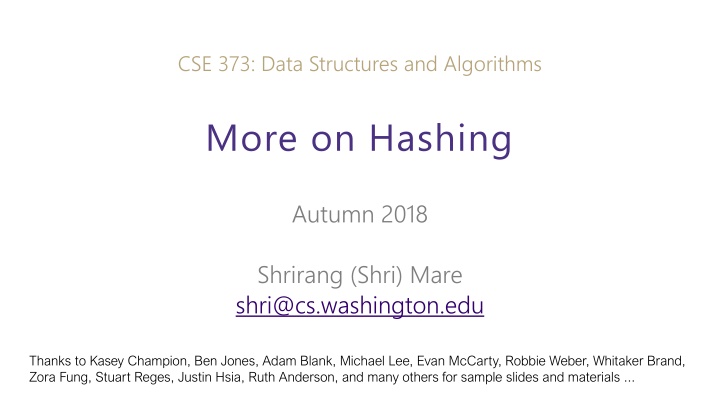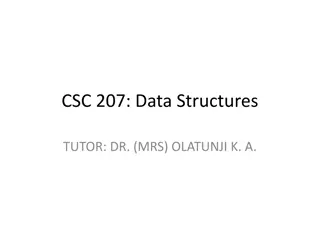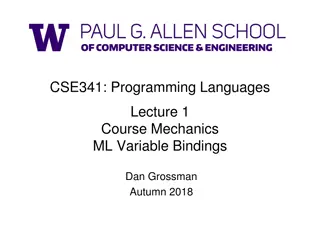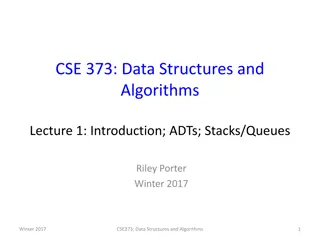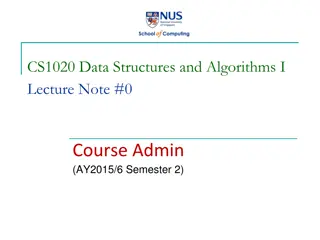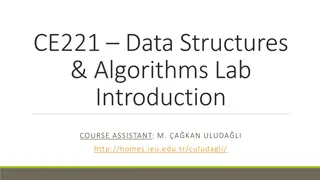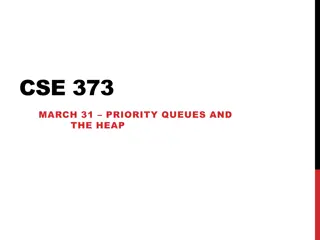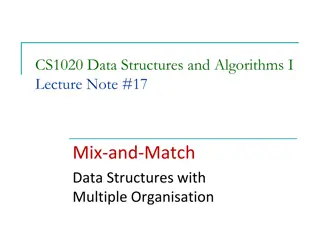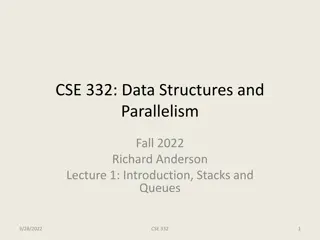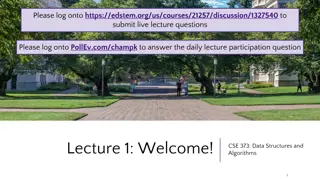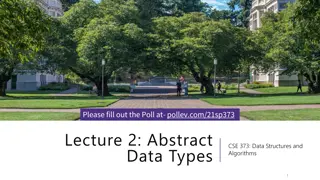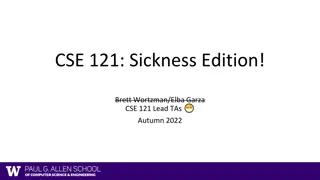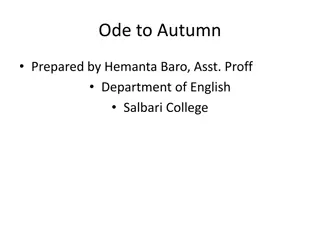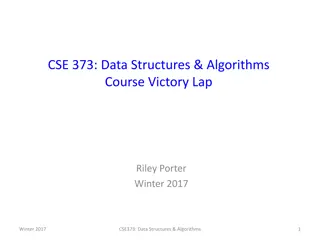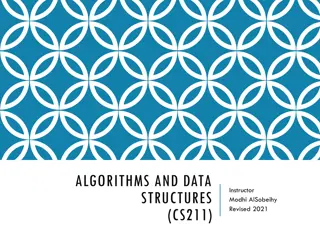Comprehensive Overview of CSE 373 Data Structures and Algorithms Course - Autumn 2018
This document provides detailed information about the CSE 373 Data Structures and Algorithms course in Autumn 2018, presented by Shrirang (Shri) Mare. It covers topics such as hashing, collision strategies, hash tables, design decisions, testing, and more. The content includes announcements, midterm topics, discussions on different hash collision strategies, review sessions, and worksheet questions.
Download Presentation

Please find below an Image/Link to download the presentation.
The content on the website is provided AS IS for your information and personal use only. It may not be sold, licensed, or shared on other websites without obtaining consent from the author.If you encounter any issues during the download, it is possible that the publisher has removed the file from their server.
You are allowed to download the files provided on this website for personal or commercial use, subject to the condition that they are used lawfully. All files are the property of their respective owners.
The content on the website is provided AS IS for your information and personal use only. It may not be sold, licensed, or shared on other websites without obtaining consent from the author.
E N D
Presentation Transcript
CSE 373: Data Structures and Algorithms More on Hashing Autumn 2018 Shrirang (Shri) Mare shri@cs.washington.edu Thanks to Kasey Champion, Ben Jones, Adam Blank, Michael Lee, Evan McCarty, Robbie Weber, Whitaker Brand, Zora Fung, Stuart Reges, Justin Hsia, Ruth Anderson, and many others for sample slides and materials ...
Announcements - Midterm info and practice material (past quarter midterms) are online. - https://courses.cs.washington.edu/courses/cse373/18au/exams.html - Midterm review sessions: 10/31 lecture and Section 05 (11/01) - Thoughts on in-class feedback collected last Friday CSE 373 AU 18 SHRI MARE 2
Midterm Topics For more info visit course website: https://courses.cs.washington.edu/courses/cse373/18au/exams.html ADT and data structures: - Difference between them, runtimes, Asymptotic analysis: - Finding c and n0, Modeling runtime, looking at a code or a model and giving Big-O runtimes, - Definitions of Big-O, Big-Omega, Big-Theta Trees: - Doing operations on trees, runtimes, AVL rotations Hash tables: - collision strategies, basics of good hash function, doing inserts in a hash table Design decisions and testing: - Given a scenario, choose a data structure and explain your choice. - Pros and cons of different implementation - How to construct different test cases CSE 373 AU 18 SHRI MARE 3
Today - Pros and Cons of different hash collision strategies - Other applications of hashing - Average-case analysis CSE 373 AU 18 SHRI MARE 4
Review: Open Addressing - Open addressing is a collision resolution strategy where collisions are resolved by storing the colliding key in a different location when the natural choice is full. put(21, value21) Note: For simplicity, the table shows only keys, but in each slot both, key and value, are stored. CSE 373 AU 18 SHRI MARE 5
Review: Collision avoidance strategies put(42, k) Quadratic Probing Linear Probing Separate chaining CSE 373 AU 18 SHRI MARE 6
Worksheet Q1-Q4 Do worksheet questions Q1-Q4 CSE 373 AU 18 SHRI MARE 7
Worksheet Q1 Quadratic Probing Linear Probing Separate chaining CSE 373 AU 18 SHRI MARE 8
Worksheet Q2 16124187,alice12,Alice,Smith,AG,JUNIOR,Electrical Engineering,alice12@uw.edu CSE 373 AU 18 SHRI MARE 9
Worksheet Q3 A. 10 all keys hash to either 0 or 5 (collisions!) B. 15 all keys hash to 0 (lots of collisions!!) C. 7 Fewer collisions but wasted table size D. 9 Fewer collisions, but one wasted space E. 11 Fewer collisions, no wasted space. (answer) (answer) CSE 373 AU 18 SHRI MARE 10
Worksheet Q4 Do mod by TableSize CSE 373 AU 18 SHRI MARE 11
Hash function with collision resolution CSE 373 AU 18 SHRI MARE 12
Hash function with collision resolution CSE 373 AU 18 SHRI MARE 13
Clustering: Disadvantage of open addressing Linear Probing Quadratic Probing Linear probing leads to primary clustering CSE 373 AU 18 SHRI MARE 14
How find works Quadratic Probing Linear Probing Separate chaining CSE 373 AU 18 SHRI MARE 15
How delete works Quadratic Probing Linear Probing Separate chaining CSE 373 AU 18 SHRI MARE 16
Resizing How do we resize? -Remake the table -Evaluate the hash function over again. -Re-insert. When to resize? -Depending on our load factor ? -Heuristic: -for separate chaining ? between 1 and 3 is a good time to resize. -For open addressing ? between 0.5 and 1 is a good time to resize.
Separate chaining: Running Times What are the running times for: insert Best: ?(1) Worst: ?(?)(if insertions are always at the end of the linked list) find Best: ?(1) Worst: ?(?) delete Best: ?(1) Worst: ?(?) CSE 332 SU 18 ROBBIE WEBER
Separate chaining: Average Case What about on average? Let s assume that the keys are randomly distributed What is the average running time if the size of the table ????????? and we ve inserted ? keys? insert find delete CSE 332 SU 18 ROBBIE WEBER
Separate chaining: Average Case What about on average? Let s assume that the keys are randomly distributed What is the average running time if the size of the table ????????? and we ve inserted ? keys? insert ?(1) ? find ? 1 + ????????? ? delete ? 1 + ????????? CSE 332 SU 18 ROBBIE WEBER
Separate chaining: Average Case What about on average? Let s assume that the keys are uniformly distributed What is the average running time if the size of the table ????????? and we ve inserted ? keys? insert ?(1) find ? 1 + ? delete ? 1 + ? ? ????????? is ? load factor CSE 332 SU 18 ROBBIE WEBER
Linear probing: Average-case insert If ? < 1we ll find a spot eventually. What s the average running time? Uniform Hashing Assumption for any pair of elements x, y the probability that h(x) = h(y) is 1 ????????? If find is unsuccessful: 1 1 21 + 1 ?2 If find is successful: 1 We won t ask you to prove these 1 21 + (1 ?) CSE 332 SU 18 ROBBIE WEBER
Summary Separate Chaining -Easy to implement -Running times ?(1 + ?) Open Addressing -Uses less memory. -Various schemes: -Linear Probing easiest, but need to resize most frequently -Quadratic Probing middle ground -Double Hashing need a whole new hash function, but low chance of clustering. Which you use depends on your application and what you re worried about.
Other applications of hashing - Cryptographic hash functions: Hash functions with some additional properties - Commonly used in practice: SHA-1, SHA-265 - To verify file integrity. When you share a large file with someone, how do you know that the other person got the exact same file? Just compare hash of the file on both ends. Used by file sharing services (Google Drive, Dropbox) - For password verification: Storing passwords in plaintext is insecure. So your passwords are stored as a hash. - For Digital signature - Lots of other crypto applications - Finding similar records: Records with similar but not identical keys - Spelling suggestion/corrector applications - Audio/video fingerprinting - Clustering - Finding similar substrings in a large collection of strings - Genomic databases - Detecting plagiarism - Geometric hashing: Widely used in computer graphics and computational geometry CSE 373 AU 18 SHRI MARE 24
Wrap Up Hash Tables: -Efficient find, insert, delete on average, under some assumptions on average, under some assumptions -Items not in sorted order -Tons of real world uses - and really popular in tech interview questions. Need to pick a good hash function. -Have someone else do this if possible. -Balance getting a good distribution and speed of calculation. Resizing: -Always make the table size a prime number. -? determines when to resize, but depends on collision resolution strategy.
